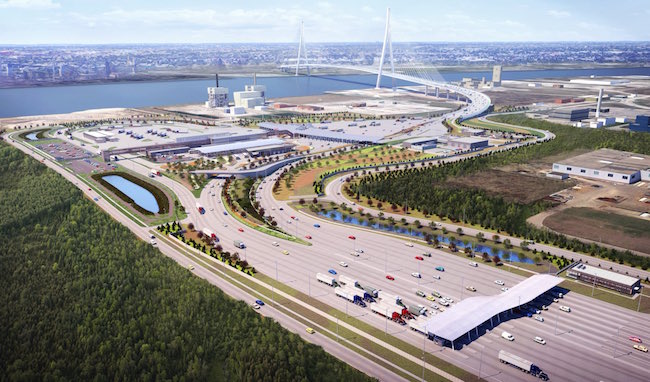
TORONTO—Construction may be officially underway on the Gordie Howe International Bridge in both Windsor, Ont. and Detroit, Mich., but it’s geotech crews out on the Detroit River and engineers working to finalize the new bridge’s design that will be logging most of the hours through the winter.
That should change as the weather turns warmer, according to Bryce Phillips, the recently-appointed CEO of the Windsor-Detroit Bridge Authority.
“Spring would be a reasonable time to see dirt moving,” Phillips said, noting how important it is that builders don’t jump the gun.
“If construction gets too far ahead, then design changes, then you have to backtrack,” he said. “The secret really is to work through those issues on the design expeditiously so you aren’t forcing decisions to get too far ahead in construction.”
On-Site sat down with Phillips last week during the annual conference of the Canadian Council for Public-Private Partnerships in Toronto, following a panel that discussed the $5.7 billion bridge project Nov. 5.
Phillips, along with other panelists, discussed the numerous obstacles the Canadian and Michigan governments, the WDBA and the bid teams faced in getting the project off the ground.
“The list is practically endless,” said Andrew Doctoroff, a senior advisor to Michigan Governor Rick Snyder. He pointed to fighting off a handful of “aggressive” lawsuits from the owners of the Ambassador Bridge, as well as obtaining more than 600 parcels of property on the U.S. side required to build the bridge and the port of entry as two of the most difficult obstacles.
All parties credited the open line of communication between the stakeholders for ensuring the project was able to move past the drawing board. They also highlighted the importance of the Canada-Michigan Crossing Agreement inked in 2012 for keeping the project on target despite political changes in both countries. Written at a time when plans for the bridge were still hazy, Doctoroff said the agreement provided enough flexibility to let stakeholders make adjustments, while also holding a hard line on certain issues.
After years of work spurred by the roadmap set out in the Crossing Agreement, the contract was finalized at the end of September, with the official start of construction following Oct. 5.
At peak, Phillips said the team anticipates a workforce of about 3,000, split nearly evenly between crews on both the U.S. and Canadian sides of the border.
According to Nuria Haltiwanger, the CEO of ACS Infrastructure, this divided workforce is one of the major logistical challenges the Bridging North America consortium needs to overcome. To set the groundwork, the construction group, which includes ACS, Dragados Canada, Fluor Canada and Aecon, set up separate joint ventures in both Canada and the U.S.
“Getting people across from one side to the other is not that realistic all the time when you’re trying to mobilize,” she told On-Site. The set-up makes particular sense because a lot of the materials are sourced from their respective side of the river, she added.
With the contract now secure, the build team is mobilizing and firming up the design for the 853-metre bridge, which will become the longest cable-stayed bridge in North America. It’s scheduled to be complete by 2024.
“The next few months really focus on finalizing design and getting designs approved and doing some of the geotech work that’ll be necessary,” Haltiwanger said. “A lot of that was done, we had some good information, but in order to get to a final design you have to continue to do that as well.”
Though she acknowledges that bridges are always a challenge, Haltiwanger said at this stage, nothing beyond cross-border logistics stands out as particularly tough about getting Gordie Howe built.
Phillips concurred, though he added that the entire P3 team will need to work together closely when issues inevitably arise. “There’s nothing obvious to us yet, but I guarantee… we will find things,” he said.





